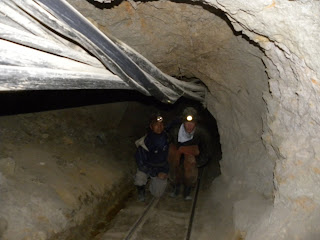The photos below are a mishmash from my trip across the salt falts of Uyuni, which was amazing and slightly terrifying (lesson learned use the best tour company in bolivia regardless of cost because the not so good companies are really bad). The salt flat itself is the largest in the world and it is truely mind boggling. We also saw geysers, and hotsprings, along with bizzarely colored lakes... laguna colorada was incredible, and lots of amazing rock formations. After my tour I headed to Potosi the highest city in the WORLD! Yep its at about 4,100m (which is taller then most of the peaks in the US). There i experienced one of the most intense couple hours of my life... The town functions beacuse of mining, presently most people work as part of a mining cooperative. They mine in tunnels where ever they want and when ever they want, and then sell the ore that they collect to the cooperative. I spent about 3 hours in the dusty asbetos filled mine shafts, I went about 2km into them and we decended over 150m down to the fourth level of tunnels. At points we were crawling on our hands and knees and on the deeper levels the temperature was over 100 degrees. We saw and spoke with a twelve year old and a fourteen year old miner... both of them began working when they were 10! They worked about 10 hrs per day and 6 days per week. On a good day they would make arround 25 bolivianos, which is leass than 4 dollars! The mine was one of the most intense and humbling things that I have ever seen... I thought I had a hard job working in mines... nope. The worst part is that there is so much asbestos and silica minerals within the mine that the average life expectancy of the mines once they enter is 12 to 20 years, before they usually die of silicosis or lung cancer... The coopertive allows people to tour the mines so that people can gain a better understaing of what happens there, it is truely eye opening.
On a lighter note...I am heading into the joungle tomorrow. After I promise to spruce up the blog posts, and I will probably expand on this one. I hope all is well at home.
Miss you all! Sorry for the crappy post, but I didnt want to leave everyone hanging.

Altipano desert

Viscacha... aka half rabbit half squirrel, enjoying lunch

Laguna Colorada

Laguna Colorada

Me holding dynamite.. yes the fuse is lit. Sorry its sideways

The mine shaft that we entered. We went 2km into the moutain and decended about 100m

Decending into the mine

Masive asbetos crystal growing from the top of one the mine shafts...

Croutching in one of the mining tunnels

Before entering the Mine outside of Potosi

The train cenmetary of Uyuni

Driving acrross the salt flats

































